

Most ebook files are in PDF format, so you can easily read them using various software such as Foxit Reader or directly on the Google Chrome browser.
Some ebook files are released by publishers in other formats such as .awz, .mobi, .epub, .fb2, etc. You may need to install specific software to read these formats on mobile/PC, such as Calibre.
Please read the tutorial at this link: https://ebookbell.com/faq
We offer FREE conversion to the popular formats you request; however, this may take some time. Therefore, right after payment, please email us, and we will try to provide the service as quickly as possible.
For some exceptional file formats or broken links (if any), please refrain from opening any disputes. Instead, email us first, and we will try to assist within a maximum of 6 hours.
EbookBell Team

4.7
46 reviewsWhat we know in European literature as One Thousand and One Nights was born as a transnational text 300 years ago. In the exact same manner, the ‘original’ tales of those early translations were born prior to the ninth century in Baghdad, by collecting and incorporating earlier tales from other cultures and literary traditions and elaborating them while appropriating them into the local culture at the same time. At times, these tales are transformations of other, earlier tales, and at times, they have striking parallels with other and later tales, which clearly demonstrates how entangled the literary world is in the past and in present times. This volume deals with One Thousand and One Nights in yet another and novel way, bringing old and new together by exploring parallels and possible origins of its tales, as well as the wealth of modern and contemporary material that it has originated and continues to inspire. The chapters included bridge any borders imposed by time and space as well as genre, and – most of all – language. They address the theory and practice of the adaptation and appropriation of One Thousand and One Nights into literature, arts, and media, while approaching a definition of our contemporary knowledge and understanding of the Nights. Thus, it underlines the dynamic nature and autonomous life that the tale collection acquired and contributes to analyzing its role in Middle Eastern narrative culture as well as its influence on world literature on one hand, and its colourful manifestations in the performing arts on the other.